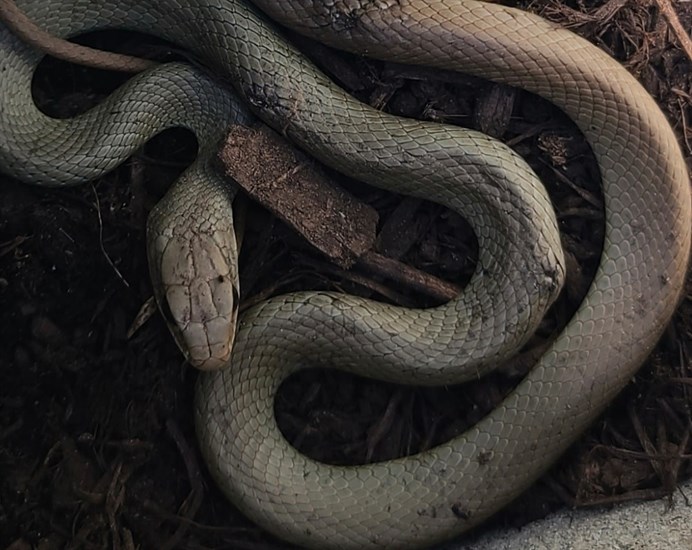
A yellow-bellied racer spotted in a garden of a Kelowna home.
Image Credit: SUBMITTED/Nick Sintichakis
June 06, 2021 - 9:00 AM
A Kelowna resident was surprised to see a yellow-bellied racer near his home, a type of snake, according to one researcher, that's losing its natural habitat.
Nick Sintichakis was in his garden in Glenmore when he spotted the racer for the first time.
READ MORE: The 7 snakes of the Thompson-Okanagan
He found the snake along the back wall of his home. He has cylinder bricks that he fills with herbs, where the snake was discovered, June 1, he said.
“It was right tucked in there and its head was buried in the dirt,” he said, adding that he picked it up and it had a yellow belly.
This is the first time he’s seen a yellow-bellied racer in the area, and he’s lived in the area since the 1990s.
The snake is common in parts of the Okanagan, but their overall range is contracting due to habitat loss, said Karl Larsen, TRU wildlife researcher who is also conducting a study on rattlesnakes and vehicle traffic.
“They are also by far the species that is most likely to get killed on the road at our White Lake study site, and they are also the species most likely to be detected by our culvert cameras. We know surprisingly little about them, but I have a couple students doing some radio-tracking on them here in Kamloops – first in Canada, I believe,” Larsen said via email.
Researchers are studying the Okanagan’s Western Rattlesnake at Inkameep Desert Cultural Centre and in the White Lake Basin southwest of Penticton to determine the mortality rates of snakes along the roads.
READ MORE: What's killing South Okanagan rattlesnakes?
Western yellow-bellied racers are long, slender snakes with large, smooth scutes (scales). Adult racers range from 50 cm to 2 m in length, according to Reptiles of B.C.
Racers are uniformly grey to olive-green on their back, and white to yellow on the belly. If grabbed, racers will (like most animals) defend themselves by biting, but if left alone they are completely harmless.
They are the only B.C. snake that will prey heavily on insects, so they are good to have around the house, according to Reptiles of B.C.
The name ‘racer’ is no accident – these snakes are built for speed. Racers are active snakes, and they use their excellent vision and speed to hunt during the day. Not only are racers good on the ground, they also are good climbers and occasionally are found hunting high in the bushes.
The racer life cycle begins in May when snakes emerge from their winter dens (called hibernacula) to mate. In July, females lay about six leathery eggs in a sandy hole or among rocks on a south-facing slope. The sun keeps the eggs warm so the young inside develop.
To contact a reporter for this story, email Carli Berry or call 250-864-7494 or email the editor. You can also submit photos, videos or news tips to the newsroom and be entered to win a monthly prize draw.
We welcome your comments and opinions on our stories but play nice. We won't censor or delete comments unless they contain off-topic statements or links, unnecessary vulgarity, false facts, spam or obviously fake profiles. If you have any concerns about what you see in comments, email the editor in the link above.
News from © iNFOnews, 2021